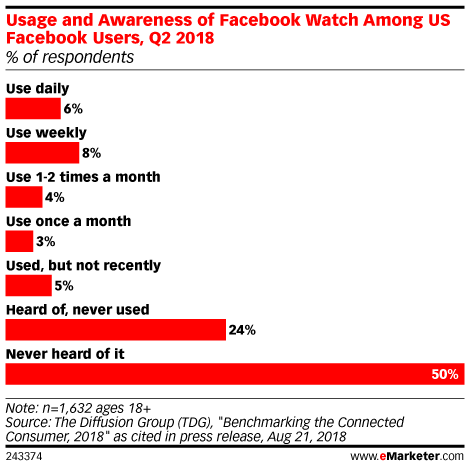oughly three months after launching Facebook Watch globally, Facebook reports that the video service has more than 400 million monthly users worldwide.
However, that includes people who spend as little as 1 minute per month on the service—and it's still a small percentage of the 1.64 billion people we expect will use Facebook by the end of 2018.
What's Holding Back Viewership?
According to a Q2 2018 survey by The Diffusion Group (TDG), half of US internet users—where Facebook Watch has been available since August 2017—had never heard of Facebook Watch. Roughly one-quarter said they had heard of, but never used, the service.


Programming may be another factor.
While several shows, including the Elizabeth Olsen-led drama "Sorry for Your Loss," garnered a lot of buzz around the premiere, only a few, like Jada Pinkett Smith's "Red Table Talk," have had continued success. As of December, Red Table Talk had 4.3 million followers on its Facebook page, with its most popular episode drawing 29.8 million views. (The most recent episode, released on Dec. 10, had 4.1 million views).
Facebook may have more luck with the video service by catering to consumers in developing countries with less money to spend on digital entertainment. Facebook Watch is free, while other digital video services like Netflix are subscription-based.
What's more, Facebook Watch will be available on Facebook Lite, a version of the app that uses less battery life and works on slower internet speeds, meaning bandwidth and device age will no longer be barriers to adoption.
Is Facebook Watch a New YouTube or Netflix ... or Something Else?
When Facebook Watch first launched in the US, it was primarily intended as a home for original, creator-led content, similar to YouTube. But when Facebook started investing in higher-quality episodic programming, it also started becoming more Netflix and Hulu-esque. As it grows its library of non-exclusive video content, which currently includes 1990s cult-classics like "Buffy the Vampire Slayer" and "Angel," it seems that Facebook is serious about taking on well-established players.
Still, Facebook Watch's place in the digital video ecosystem will probably be unique. Despite its various forays into video in 2018, Facebook is first and foremost a social network, and that will set it apart from pure-play digital video platforms.
One example is Facebook's Watch Parties, which allow users to watch videos on Facebook together in real-time and interact with each other. Whether that and similar social initiatives drive more Facebook Watch usage remains to be seen.
source:here
:: بازدید از این مطلب : 459
|
امتیاز مطلب : 0
|
تعداد امتیازدهندگان : 0
|
مجموع امتیاز : 0

